This CE Center article is no longer eligible for receiving credits.
Surf and Turf
Brooklyn Bridge Park by Michael Van Valkenburgh Associates nears completion with Pier 3.
BY BETH BROOME
OVER 20 YEARS, Brooklyn Bridge Park, designed by Michael Van Valkenburgh Associates (MVVA), has transformed a 1.3-mile stretch of a once-gritty industrial waterfront into a lush and treasured resource for New York. The completion of Pier 3, one of the last major elements—and the final of five piers to be developed—has been timely, providing a verdant landscape for locals to retreat to during the pandemic. With its loosely defined program, this park on a pier has drawn a range of visitors as they temporarily leave behind the stresses of dense urban living during a summer of COVID restrictions.

PHOTOGRAPHY: © ELIZABETH FELICELLA, EXCEPT AS NOTED; ALEX MACLEAN (LEFT)
PIER 3 abuts the busy BQE on one side, faces Manhattan on the other, and sits adjacent to Pier 2’s basketball courts (left). Cedar dune fencing and recovered black locust log “benches” offer coastal references (right).
The long, narrow 85-acre park is squeezed between the Brooklyn–Queens Expressway and the East River, a tidal estuary, with Manhattan’s skyline just beyond. Managed by the not-for-profit Brooklyn Bridge Park Corporation, the park includes eight acres of private development—largely condos and a hotel—that provides the income for maintenance and operations. The first portion, Pier 1, was completed in 2010 (ARCHITECTURAL RECORD, January 2011). Today, the park—which attracts over 5 million visitors annually—includes piers dedicated to soccer fields and basketball courts, as well as playgrounds, a marina, fishing and barbecuing areas, zones for kayaking, and a spine-like greenway along the shore that links the pieces and is well-used by cyclists and runners.
To this mix, Pier 3 brings 4.6 acres of cultivated nature and recreation space, a balance of active and passive use. “Pier 3 provides a different take on the concept of play, as well as a more traditional pastoral destination,” says Michael Van Valkenburgh. “Brooklyn Bridge Park is extroverted, water-centric, but with Pier 3, we wanted a place that was more introverted.” Retaining the steel frame of the warehouse that once occupied the pier, the team left the original concrete deck at the perimeter exposed, to create a promenade. Passing across this rough industrial edge and through the steel ghost of the warehouse, you enter a green oasis.


PHOTOGRAPHY: © KELCO CONSTRUCTION
THE AMORPHOUS shape of the central lawn creates nooks for gathering.
The biggest challenge of putting landscape on a site like this, points out MVVA principal Jason Siebenmorgen, is accommodating the weight of soil—especially the depth required for shade trees. In the project’s early stages, the pier’s existing wood piles were reinforced with rebar and concrete that was pumped into fiberglass forms installed to surround them. Existing seawalls were then removed and replaced with riprap edges on the adjacent shoreline. Finally, to create some separation from the mainland, the team cut out the deck that connected the pier to the greenway, installing two concrete bridges instead. To build topography on this flat surface without overloading the structure, MVVA erected a system of lightweight geofoam blocks. Pier 3 (most of which sits below the 100-year-flood line) is designed to withstand water inundation. Because 2012’s Hurricane Sandy flooded the park and dislodged the foam on Pier 5, a geotextile was used this time to anchor the material. On top of this is a 30-inch layer of sand, subsoil, and topsoil. Runoff (greatly reduced by the dramatic reduction of impervious surfaces) flows into plant beds, with their porous sandy soil mix; the rest is directed into the East River.

PHOTOGRAPHY: SCOTT SHIGLEY
Toward the water, the scale of plantings diminishes. Mooring bollards add to the Discovery Garden’s playscape (opposite, bottom).
Hillocks and gentle rises lend this park-within-a-park a bowl shape, and define its expansive central lawn, which is flanked by meandering paths, an open event plaza, and the labyrinthine Discovery Garden, with its funhouse mirrors and “whisper room.” In plan, the lawn resembles an amoeba, with numerous curvy nooks, perfect for small private gatherings and picnics. “We had never heard of social distancing when we designed the park,” says Van Valkenburgh. “But the concept was there—in the public realm, many of us like to have separation.” Low cedar dune fencing appears to be holding back dense growth as if to prevent it from jumping out onto the tamed grass.
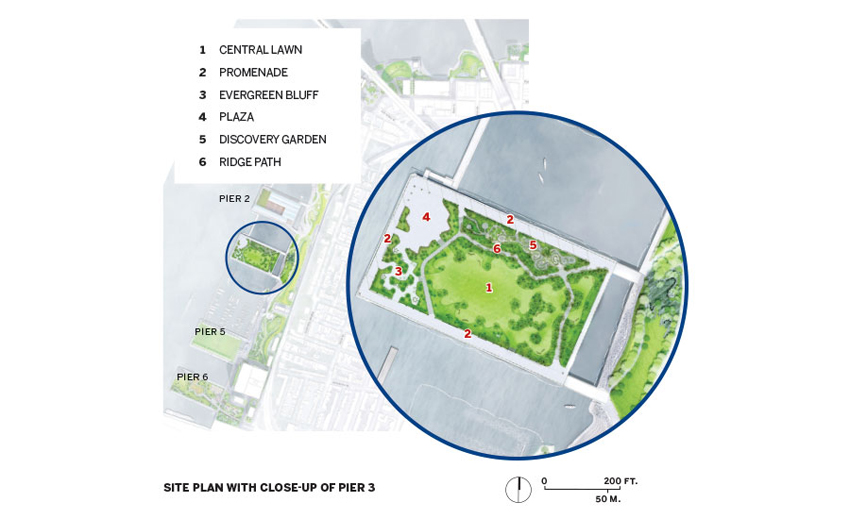
MVVA used a resilient, salt-tolerant plant palette that includes bayberry, beach rose, witch hazel, switch grass, and quaking aspen. Juniper brings year-round greenery. The horticultural staff here is deeply invested in ecology, says Siebenmorgen: Brooklyn Bridge Park is managed organically, irrigation is used sparingly—largely to help establish new plantings—and maintenance is adjusted according to such things as pollination studies, which might, for example, indicate when to prune. This jibes well with MVVA’s “natural and rowdy” general aesthetic, notes Siebenmorgen. “Plants are not sitting clipped and well-behaved in the corner,” he says. “They brush up against your ear or touch your arm—it’s about that kind of physical interaction.” While larger plantings—oak, black cherry, coffee trees, lindens, and hedgerows—are inland, moving toward the waterfront, the scale comes down with scrubby specimens such as sea kale, sassafrass, salt shrub, Mauntauk daisy, and beach pea. The overall effect is that of an accelerated trip through a chain of microclimates: from forest to meadow to headland.
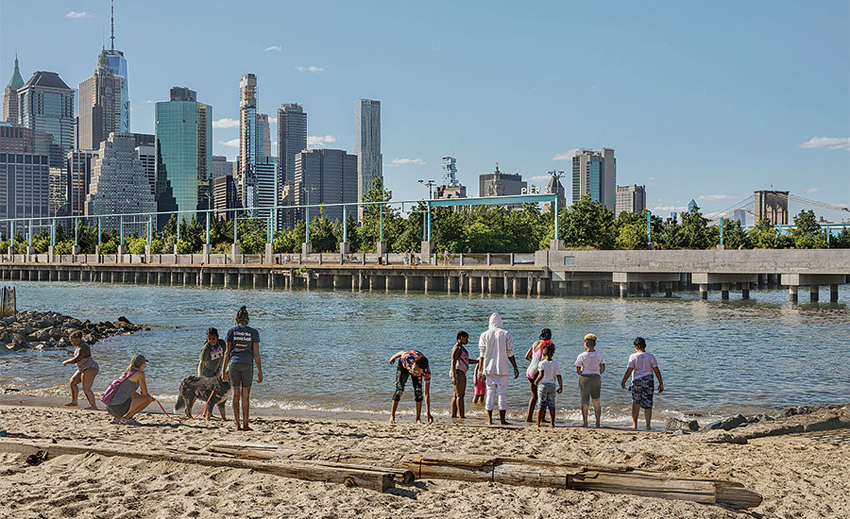
A SANDY BEACH facing Pier 3 is a popular play spot. Steel framing from a former warehouse delineates the lush interior of the pier, and new concrete bridges connect it to the mainland.
In recent months, the park’s users have changed dramatically. Gone are the tourists, which usually make up about a third of visitors, and there are fewer New Yorkers from distant ends of the boroughs. But even during the lockdown, Pier 3’s—and the larger Brooklyn Bridge Park’s—mission to bring respite to the diverse city has not changed. “We’re all very different, and we’re not really all that very different,” says Van Valkenburgh. “We think we’re moving fast-forward on a rocket ship, which in many ways we are, but not experientially. Smelling a rose a hundred years ago affected my grandfather the same way it affects me. That’s what I love about landscape: its enduring quality, no matter what your background is.”
Credits
Architect: Michael Van Valkenburgh Associates — Michael Van Valkenburgh, Matthew Urbanski, Paul Seck, Scott Streeb, Andy Wisniewski, Nik Elkovitch, Jason Siebenmorgen, Tyler Krob, Leo Miller
Engineers: CH2M/Jacobs (marine); Altieri Sebor Wieber (electrical); E2PM (structural)
Consultants: Domingo Gonzalez Associates (lighting); F2 Environmental Design (soil science); Northern Designs (irrigation); CNC Construction (concrete benches); Open (graphic design)
General Contractor: Kelco Construction
Client: Brooklyn Bridge Park
Size: 4.6 acres
Cost: $13 million (landscape); $13 million (marine)
Completion date: July 2018
Sources
Landscape Furnishings: MVVA custom
Play equipment: Richter Spielgeräte
BUILDING TYPE STUDY 1,020
LANDSCAPE
This summer, in the wake of pandemic isolation, access to outside space is more important than ever before. But successful parkland and landscapes cannot be simply about respite and recreation alone: as climate change intensifies, resilience is equally critical. The projects on the following pages—from the cultivated to the untamed—provide healthy escapes, demonstrate a sensitivity to local conditions, and combat the effects of a warming planet.
Hedging Your Bets
Shrouded in greenery, a mixed-use complex by Ingenhoven Architects reshapes a plaza at the heart of Düsseldorf.
BY JOANN GONCHAR, FAIA
VISITORS TO Gustaf-Gründgens-Platz in the center of Düsseldorf, Germany, might initially think that the 90-foot-tall off-kilter box shrouded in precisely clipped shrubs is a living sculpture or some sort of oversized topiary. The mysterious volume at the plaza’s southern edge is, in fact, enveloped in nearly 30,000 hornbeam hedges. And, if laid end to end, they would stretch nearly five miles, making the installation Europe’s largest green facade, according to Ingenhoven Architects, the project’s designer. But underneath this leafy layer, and within a smaller adjacent triangular structure topped with a sloping lawn, are 450,000 square feet of retail and office space. The only hint of human occupancy, at least from the vantage point of the plaza, are a set of glazed portals inserted within the hedges that lead to the office tenants’ elevator lobbies.
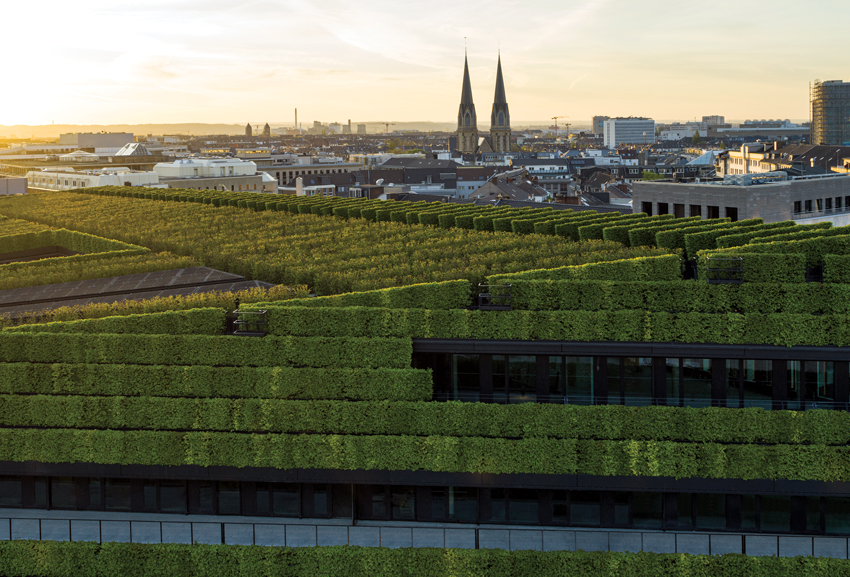
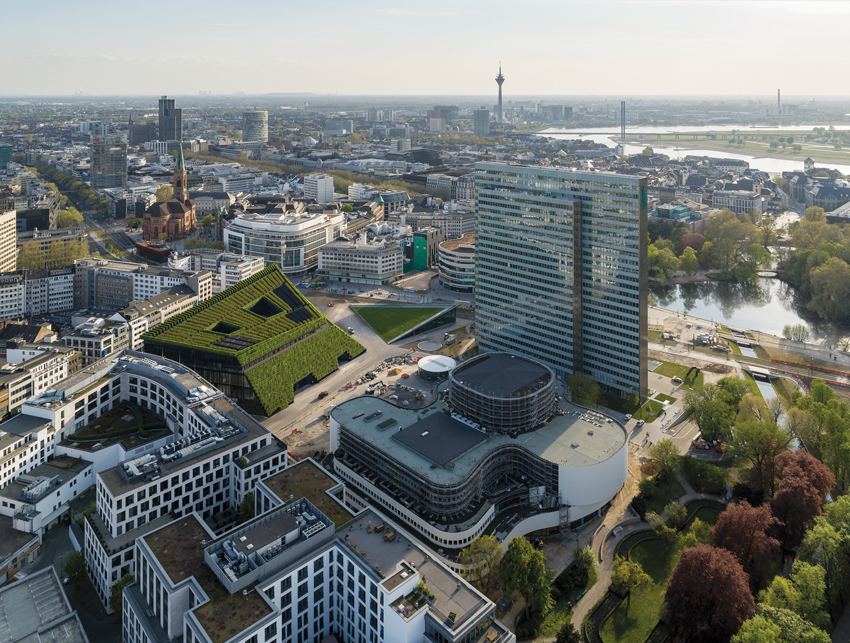
PHOTOGRAPHY: © HANS-GEORG ESCH
THE DEVELOPMENT’S shrub-covered building has a terrace that wraps its fourth floor (left). This volume, along with a smaller sloping lawn-topped structure, defines a new entry for a plaza that is also home to the state theater and an office tower (right).
Kö-Bogen II, as the project is known, is not the first in which the firm has linked landscape and architecture so thoroughly that it is difficult to determine where one ends and the other begins. In 2017, the architects completed Marina One (RECORD, July 2018) in Singapore in collaboration with the landscape firm Gustafson Porter + Bowman. The residential and commercial development has a junglelike profusion of tropical vegetation that grows within a central court and from terraces and rooftops. In Düsseldorf, Ingenhoven Architects has taken a more controlled approach, selecting the hornbeam, a native coniferous tree whose leaves turn brown in the fall but stay on the branches all year round. These shrubs have been groomed to maintain a rectilinear profile and create a manicured—or what firm founder Christoph Ingenhoven calls a “dominated”—version of nature.
One motivation for all the greenery was to refer to a beloved nearby park, the Hofgarten, while lending the mixed-use complex an expression distinct from two landmarks that also border Gustaf-Gründgens-Platz—the Dreischeibenhaus (1960), a 25-story Miesian office tower, and the Schauspielhaus (1970), an organically curved state theater that Ingenhoven Architects is currently renovating. “We didn’t want to compete with the two icons,” says Ingenhoven. “The third building on the plaza had to be completely different.”
The project is the culmination of Ingenhoven’s decades-long preoccupation with the center of Düsseldorf—the city where his international practice is based. Since the early 1990s, he had been advocating for removal of a postwar-era multilane roadway elevated on piloti. It sliced through the urban fabric, dividing the Hofgarten in two and isolating the Dreischeibenhaus and the Schauspielhaus from much of the city. In large part due to Ingenhoven’s efforts, the thoroughfare was finally torn down in 2013 and replaced with a tunnel system. Meanwhile, Kö-Bogen I, designed by Daniel Libeskind, was built on the opposite side of the elevated highway. That mixed-used complex, comprising a pair of sinuous structures connected by a pedestrian bridge, anticipated the roadway’s removal, opening soon after demolition was complete. Ingenhoven’s firm subsequently won an invited competition for Kö-Bogen II, which he saw as an opportunity to reimagine the Gustaf-Gründgens-Platz and highlight the relationship between the theater and the office tower. The scheme not only provides a sharp contrast to the two existing buildings, but the combination of the sloping lawn and the shrub-covered facade form a void or a “valley” that frames these older structures and also defines a new entry to the plaza.
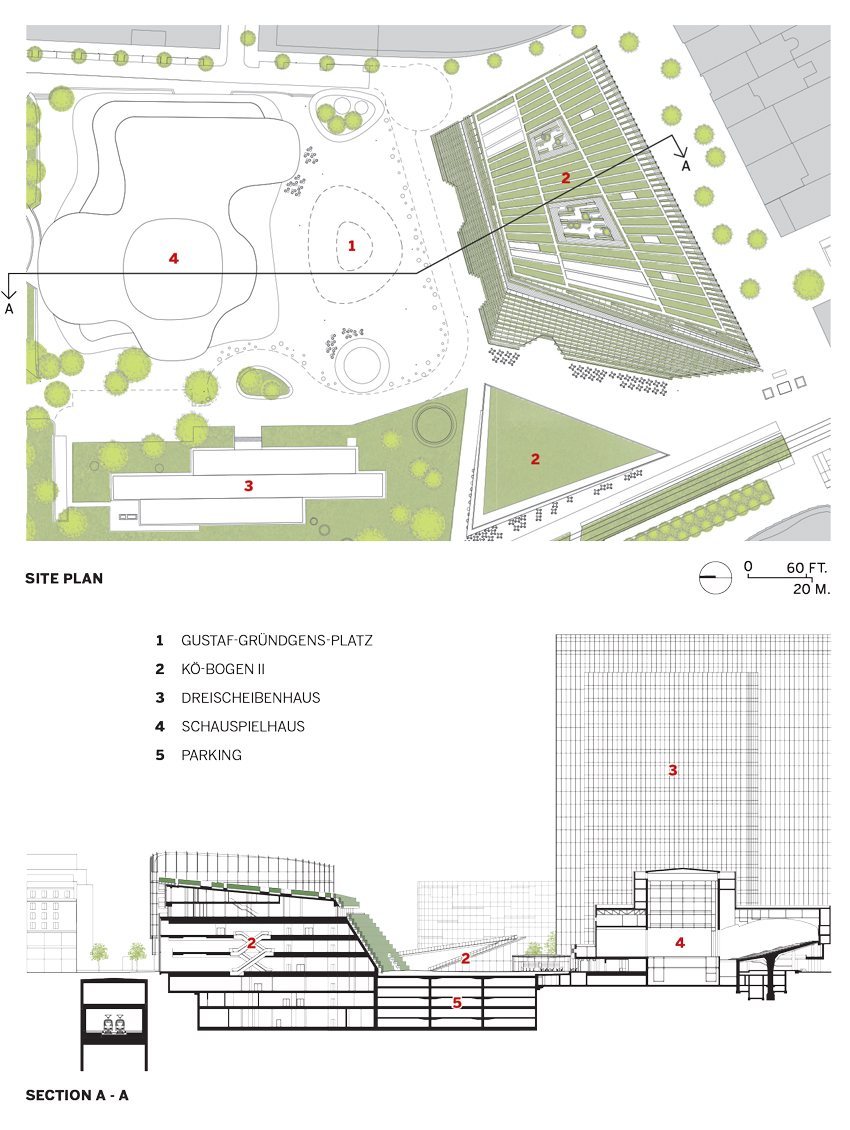
PHOTOGRAPHY: © HANS-GEORG ESCH
Above five levels of underground parking, Ingenhoven’s reinforced-concrete structures are organized so that the smaller, triangular one and the basement and first three floors of the trapezoidal one are devoted to retail (its top two levels house offices). And although, from Gustaf-Gründgens-Platz, the larger volume appears almost entirely wrapped in shrubs, its south facade, which faces a major shopping street, is glazed, as is the east facade. The other two elevations are clad in metal panels, with the hornbeam planting beds, each 18 by 40 inches, supported on their own armature, which includes a system of cages that travel on rails, allowing horticulturists to access the shrubs. (The roof is also covered in hornbeams, but these are more conventionally supported). The arrangement provides one facade for the retailers, who generally prefer mostly black-box store environments, to place signage and showcase their wares, while allowing some connection to the city. A terrace wrapping the building’s fourth floor and tucked between the rows of hornbeams on the north and west faces gives office workers access to daylight, views, and fresh air.

PHOTOGRAPHY: © HANS-GEORG ESCH
THE HORNBEAMS were installed during the winter, when their leaves are brown (right). The only indications of human habitation from the plaza are ground-level portals set within the shrubs (left).
Despite some delays due to COVID-19, the shops are slated to open this fall, with the first office tenants moving in at the end of the year. But Kö-Bogen II should provide advantages for city residents—even before anyone steps inside. The sloping lawn, for instance, is accessible for people to lounge and enjoy the sun. The hornbeams create ecological benefits, including storing as much carbon as 80 fully grown trees, says the project team. Karl-Heinz Strauch, a specialist in phytotechnology, helped develop the plan for the hornbeams’ irrigation, nutrients, and pruning. He has thoroughly investigated the bushes, in addition to monitoring the individual selected shrubs at the nursery in northern Germany, where they had been growing in their planters since 2016 before being installed on the building early this year; he studied a full-scale mock-up of one corner erected near the site and worked with specimens at his lab at Beuth University of Applied Sciences in Berlin. Strauch knows how much water the engineered soil mix can hold, how long it takes for each hedge’s root system to fully form, and the plants’ rate of transpiration (the process through which they give off water vapor through their leaves). He points specifically to urban heat-island mitigation, explaining that the plants will prevent the building envelope from absorbing solar radiation and then warming the adjacent air.
Should any plants fail, they could be swapped out by crane. But Strauch sees this as unlikely, assuming that the maintenance regimen—including clipping the shrubs back about three times a year and periodic fertilization—is adhered to. The living facade comes with a 99-year warranty. “If replacement is necessary, it will be far into the future.”
For Ingenhoven, this aspect of the project’s performance is part and parcel of his larger sustainability and urban place-making goals. As architects, “we have to ask what our buildings do for the city,” he says. “We can’t do things merely because they are beautiful.”
Credits
Architect: Ingenhoven Architects — Christoph Ingenhoven, Peter Jan van Ouwerkerk, Cem Uzman, Mehmet Congara, Ben Dieckmann, Patrick Esser, Vanessa Garcia Carnicero, Yulia Grantovskikh, Tomoko Goi, Olga Hartmann, Jakob Hense, Melike Islek, Fabrice-Noel Köhler, Christian Monning, Daniel Pehl, Andres Pena Gomez, Peter Pistorius, Lukas Reichel, Jürgen Schreyer, Susana Somoza Parada, Jonas Unger, Nicolas Witsch, Dariusz Szczygielski, Stefan Boenicke, Thanh Dang, project team
Consultants: Schüßler-Plan Ingenieurgesell-schaft (structure); Werner Sobek Group (facades); Ingenieurbüro Dr. Bleiker (building services); CEP City-Elektroplanungs-Gesellschaft (electrical); Tropp Lighting Design (lighting); Karl-Heinz Strauch (phytotechnology); Albert Reif (vegetation ecology); Heinz Jahnen Pflüger (urban planning)
Building shell Contractor: HOCHTIEF Infrastructure, LEONHARD WEISS-Group
Client: Düsseldorf Schadowstraße, CENTRUM Projektentwicklung
Size: 450,000 square feet
Cost: withheld
Completion date: August 2020
Sources
Cladding: FRENER & REIFER
Green facade: Jakob Leonhards Söhne
Irrigation: Mastop Totaaltechniek
Lighting: Zumtobel Lighting, WILA Lichttechnik
Closers and exit devices: Dorma, GEZE Elevators/Escalators: KONE, Windscheid + Wendel
Water World
OJB Landscape Architecture manages flooding naturally in an exurban Houston development.
BY SUZANNE STEPHENS
TEXAS IS one of those places where it’s still possible to have land, lots of land, close by a major city. Such is the case with Springwoods Village, once a 2,000-acre forested property on the northern edge of Houston, now being transformed into a mixed-use community, including office, residential, retail, recreation, and greenspace. And the developer, CDC Houston, has added a natural water-management system to its agenda. While the parent company, Coventry Development Corporation, had acquired the land in the 1960s, it wasn’t until after 2000, when ExxonMobil bought 400 acres of the property for its main North American campus, and a beltway (Grand Parkway) was constructed around much of Houston’s outskirts, that Springwoods Village took shape. In 2010, CDC embarked on a master plan to develop a $10 billion project on the remaining 1,600 acres, with 4,000 to 5,000 houses and apartments projected to be built within commuting distance of downtown Houston, 25 miles away.
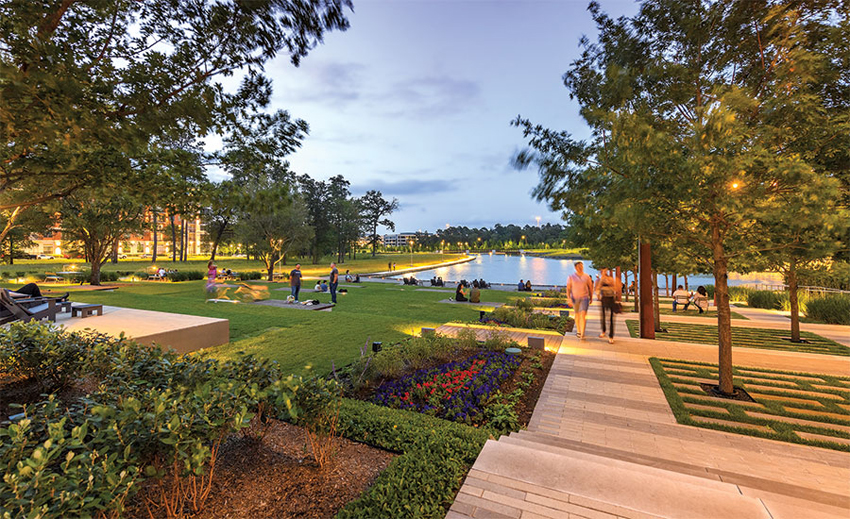
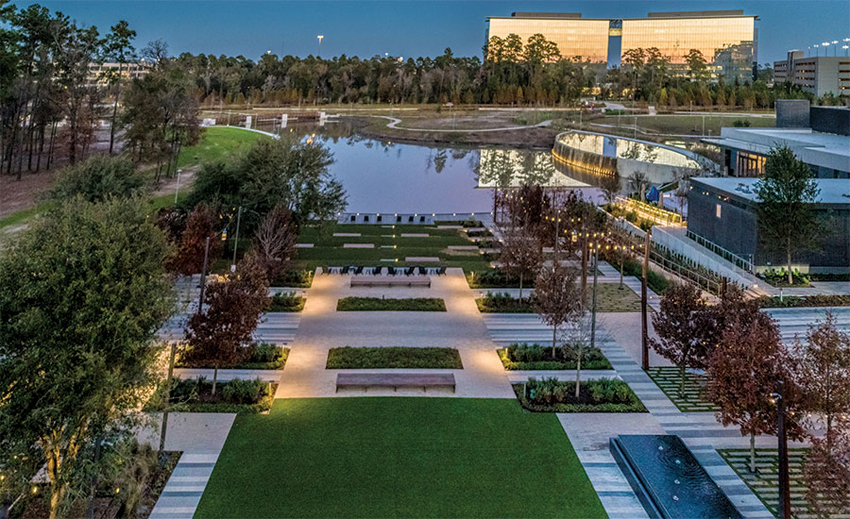
PHOTOGRAPHY: © GEOFF LYON
CITYPLACE is a residential, office, and hotel enclave organized around a linear plaza (left). Lawns (right) draw residents and the public to the man-made freshwater pond at the edge of the plaza.
One significant aspect of Springwoods Village is the inclusion of large swaths of landscape. In a recently completed area in the eastern portion of the development, CDC commissioned OJB Landscape Architecture to design and construct a landscape component, finished in 2016, that provides recreational features and aids in stormwater management. The 32-acre CityPlace Park is composed of waterfalls, bridges, and trails, with ipé boardwalks threading through a landscape planted with buffalo grass, prairie wildrye, and Texas cupgrass, as well as cypress, water oak trees, and loblolly pines. Included within this park is an entity given the evocative name of Drainage Corridor-1 (DC-1) and composed of a string of eight man-made ponds to mitigate flooding. “We wanted to make sure our stormwater-management system would be seen as an amenity, so we combined it with the large park,” says Warren Wilson, executive vice president of Coventry Development. To its credit, the drainage corridor not only does a lot of invisible work during extreme weather “events” but looks as if it has always been there.
Contrasting with CityPlace Park, which comprises DC-1, is a second component, the urbane 60-acre enclave called CityPlace, whose infrastructure was finished in 2019. Here a mix of office buildings, hotels, multi-family residences, retail shops and restaurants are open or in construction, organized around a large linear plaza that gradually descends east to meet DC-1 and its lush environs.
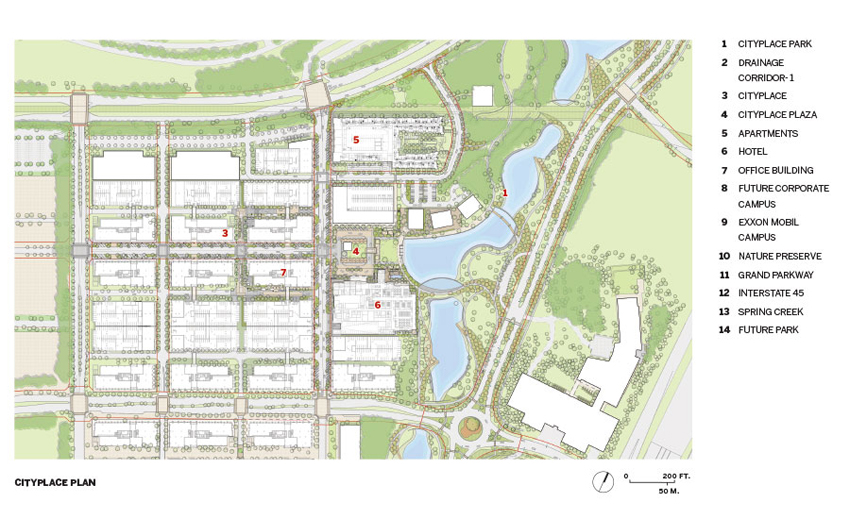
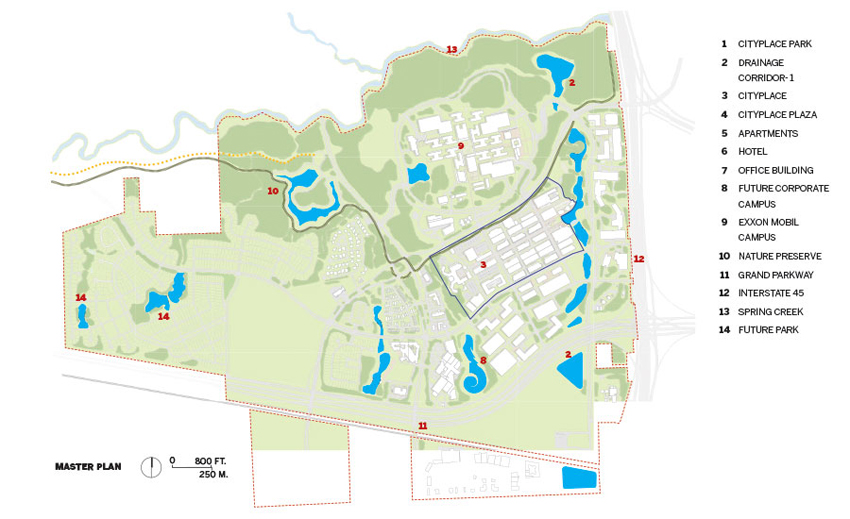
PHOTOGRAPHY: © GEOFF LYON
While Houston-based OJB was in charge of all the landscape design, as well as the master plan for the drainage corridor and park, the firm worked with Gensler on CityPlace’s overall master plan. This component features a grid of 250-by-400-foot blocks and the stretched-out plaza, softened by vegetation. Grass energetically sprouts up in the 7-inch joints between limestone pavers. Along with rectangular stainless-steel fountains, the pavers reinforce a rational design scheme—its artificial character contrasting nicely with the biomorphic park.
Yet the most important element of this two-part complex is the infrastructure of the drainage system, especially since its purpose is hidden and designed to look natural. CDC was crucially aware of the need to have strong stormwater management: the region is famous for its flatness and flooding, and climate change means not only a warmer but also a wetter future. While the developer had initially cleared land for Springwoods Village’s unfolding, the company wisely embarked on a green initiative that includes planting over 2,200 trees in CityPlace Park and CityPlace as part of a reforestation effort.
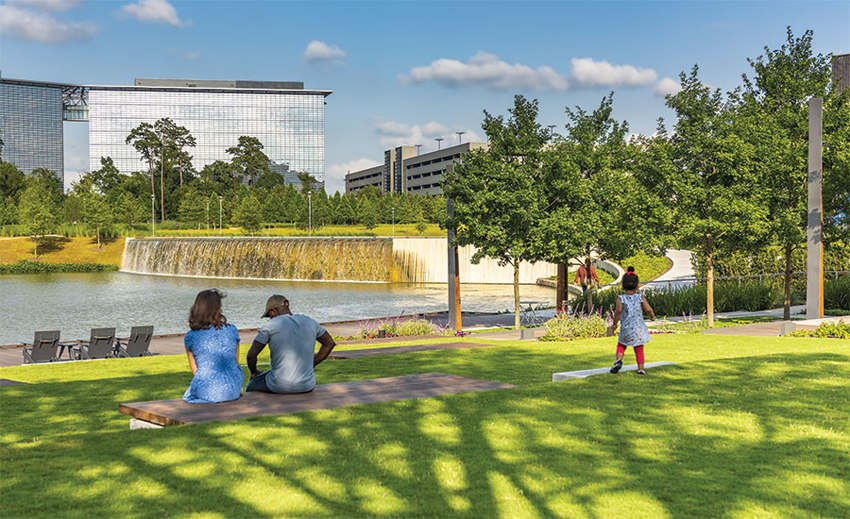
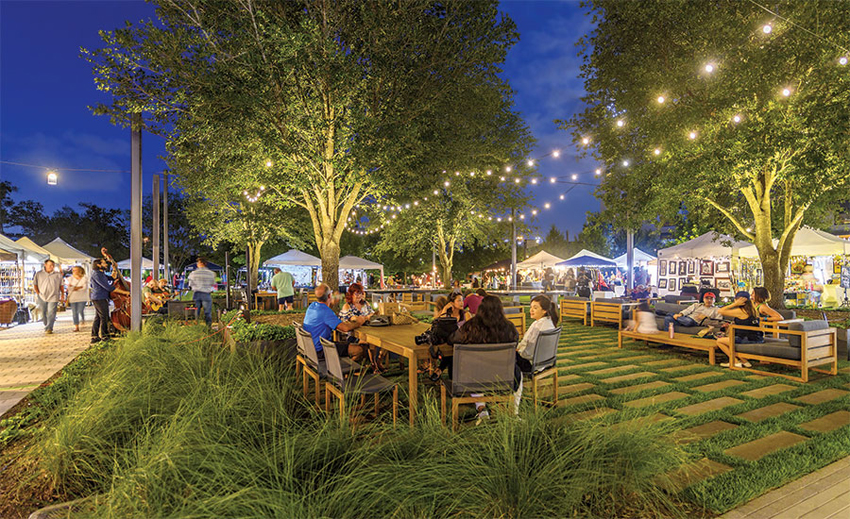
PHOTOGRAPHY: © GEOFF LYON
A WATERFALL attracts visitors in CityPlace’s plaza (right), where the elevation drops naturally, descending gradually to the man-made pool of the drainage system. The plaza features plantings of local species along with seating, and tents put up for various festivities (left, right).
Springwoods Village as a whole complies with county requirements for low-impact development and green infrastructure practices, but also benefits from a designation as an improvement district, which enables the county to collect property taxes to construct and operate the infrastructure for storm drainage, wastewater treatment, and water supply.
The timing was crucial. DC-1 and CityPlace Park were already in place when Hurricane Harvey hit in 2018, so the area impressively survived 30 inches of rainfall that spilled down in four days—FEMA called it the largest amount of rainwater from a single storm documented in the U.S.—without serious flooding of the development’s businesses and homes.
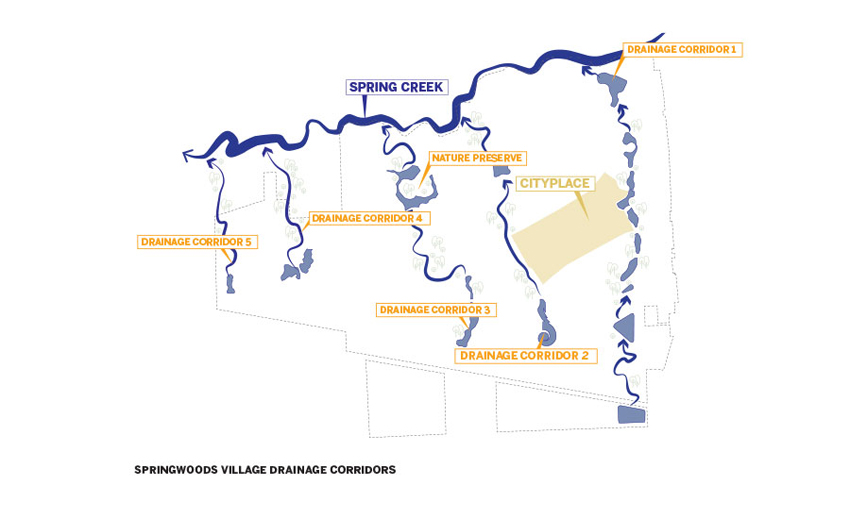
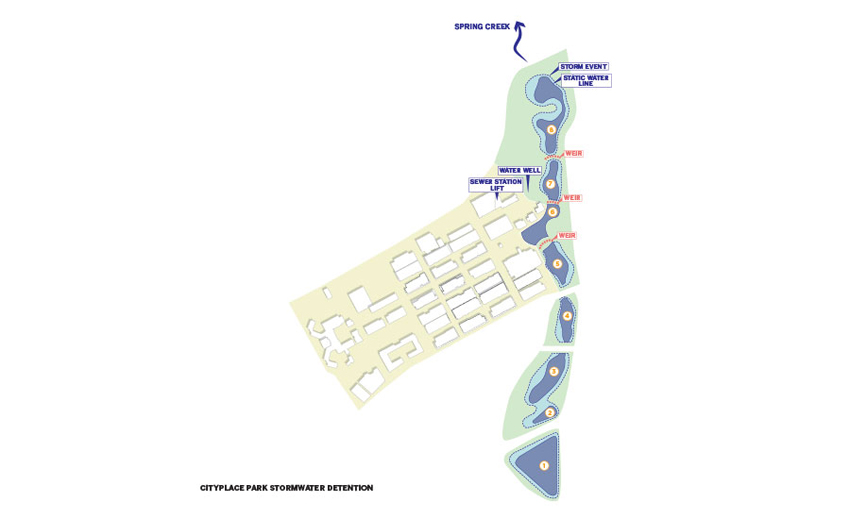
PHOTOGRAPHY: © GEOFF LYON
FIVE DRAINAGE CORRIDORS hold stormwater runoff for the entire Springwoods Village (above). One, DC-1, has eight freshwater ponds and several weirs to help detain water for CityPlace Park (below). During a storm event, the ponds, helped by the weirs, discharge overflow into Spring Creek.
In addition to DC-1, four more drainage corridors serve the entire Springwoods Village area. When flooding occurs, corridors detain the water and gradually discharge the overflow into Spring Creek, which runs into the man-made Lake Houston. “We wanted to avoid putting water into pipes,” says Chip Trageser, OJB’s design lead on DC-1. “We just needed to slow it and let it gradually drain into Spring Creek.”
DC-1 is the most dramatic piece of the stormwater-infrastructure system in the Springwoods Village development. Its ponds altogether hold about 50 million gallons of water normally, but can accommodate 126 million gallons during a storm. This system also decontaminates, desilts, and moves treated effluent from the drainage area to Spring Creek. And the ponds and weirs do welcome the occasional kayaker.
As part of the decontamination effort, the landscape architects installed aquatic plants that take out impurities such as fertilizers
and help prevent algae growth. Shrubs, native grasses, and wild flowers planted between impermeable surfaces and the ponds help filter out heavy metals, oils, and other pollutants. And the slowing of the flow of water by the vegetation helps it infiltrate into the ground.
The vast green acres of the parks and open spaces attract the public from the metropolitan area outside Springwoods, says Wilson, acting as a magnet to outdoor activities. The bridges over ponds and trails invite the experience of “nature,” where visitors can escape the hot, sticky Texas weather: Trageser points out that the tree canopy causes the temperature to drop as much as 10 degrees Fahrenheit. Depending on the season, the wild flowers and native grasses add touches of color and scent.
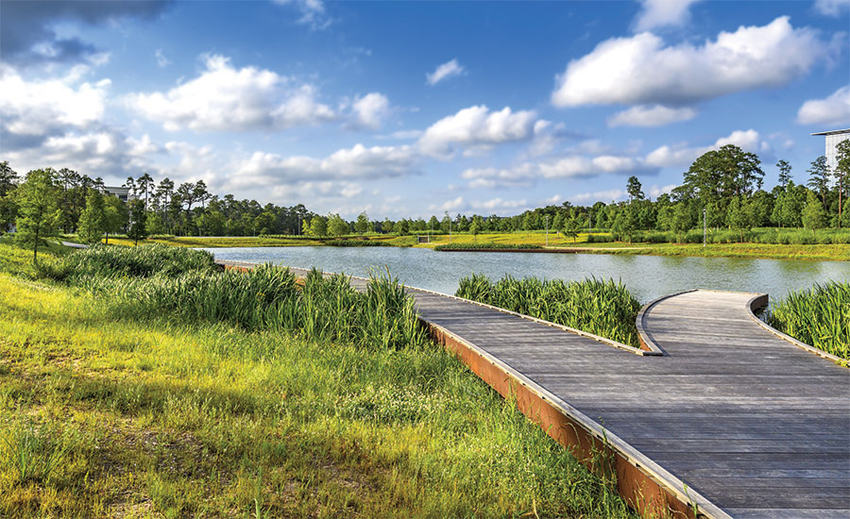
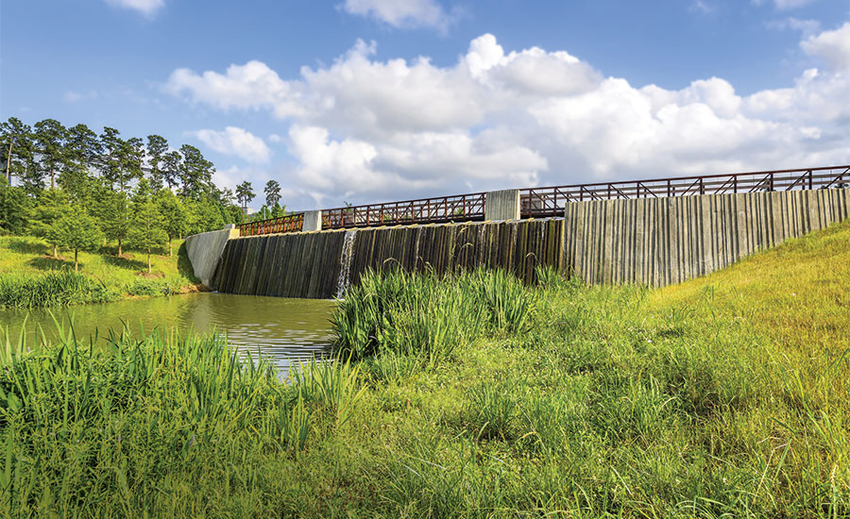
PHOTOGRAPHY: © GEOFF LYON
AS PART of the park, boardwalk and trails take visitors past the ponds (left). The weir structures (right) mark the drop in elevation between the ponds, generating waterfalls, while storm overflow is drained into Spring Creek.
In CityPlace’s plaza, people like to sit beneath the trees, or explore open-air festivities set up under tents. This is a more social idea of connecting to the outdoors. Yet in both of these two man-made landscapes of Springwoods Village, OJB has given a strong hand to nature with its environmentally sound design. The land may be plentiful, but it does benefit from a judicious intervention.
Credits
Architect: OJB Landscape Architecture — Chip Trageser, design lead; Tyler Jurney, project manager
Architect of Record for CityPlace: Gensler
Engineers: Walter P. Moore (civil and structural); Wylie & Associates (electrical); Jacobs (district engineer)
General Contractor: L.N. McKean Construction
Consultants: BergOliver Associates (environmental services/land use); Sweeney & Associates (irrigation); Lake Management Services (pond management)
Client: Coventry Development Corporation
Size: 32 acres (CityPlace Park); 60 acres (CityPlace)
Cost: withheld
Completion date: June 2016 (CityPlace Park); June 2019 (CityPlace infrastructure)
Sources
Concrete Unit Paving: Pavestone
Pedestrian Bridge: Contech Engineered Solutions
Lighting: Selux Saturn Cutoff LED; Louis Poulsen’s Kipp Post LED; Hess America; Tivoli
Child’s Play
Mithun deftly orchestrates a new site for the Louisiana Children’s Museum by a lagoon in the Big Easy.
BY JOSEPHINE MINUTILLO
WHEN HURRICANE KATRINA devastated New Orleans 15 years ago this month, the site where the Louisiana Children’s Museum (LCM) now sits was under several feet of water. Back then, the museum was housed in a brick building in the Warehouse District. “The idea to move was not because of a plan to expand. It was motivated by a need for the city and state to invest in children differently,” says LCM CEO Julia Bland, whose mission for the museum went beyond entertaining children for a few hours. Louisiana has consistently ranked among the worst states for children’s education and health. “We needed to create a space to bring many different resources together. We were on the bottom of all the good lists and the top of all the bad lists.”
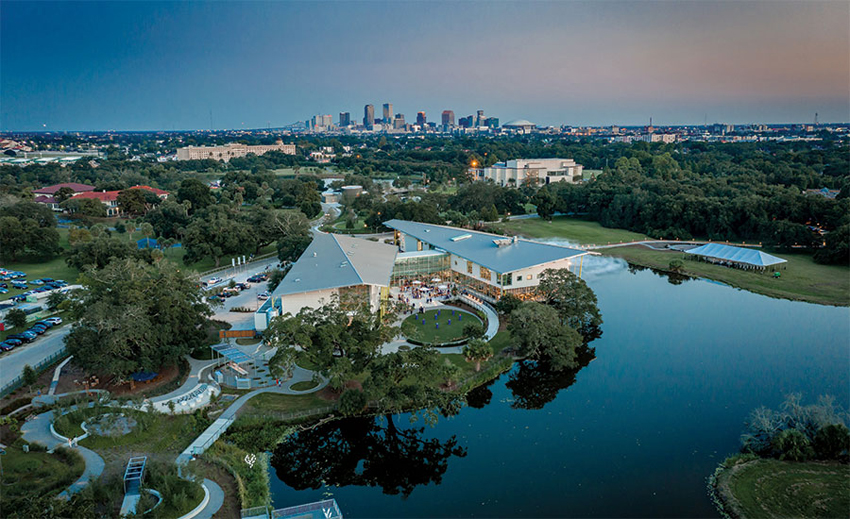
PHOTOGRAPHY: © KEVIN BARRACO
LCM engaged Seattle-based architecture firm Mithun, which includes a landscape architecture practice, to negotiate the 8.4-acre site, located within the world’s largest grove of live oaks, in City Park. One of the country’s oldest urban parks, it was built on swampland and incorporates 137 acres of water bodies within a man-made lagoon system that circulates between Lake Pontchartrain and Bayou St. John. The museum’s new 54,600-square-foot home is spread out between two linked two-story structures that were carefully sited to protect the oaks while enhancing the nearby lagoon. “Because we took an integrated approach to the design, we did not put the front door at the drop-off,” says Mithun landscape architect Christian Runge.
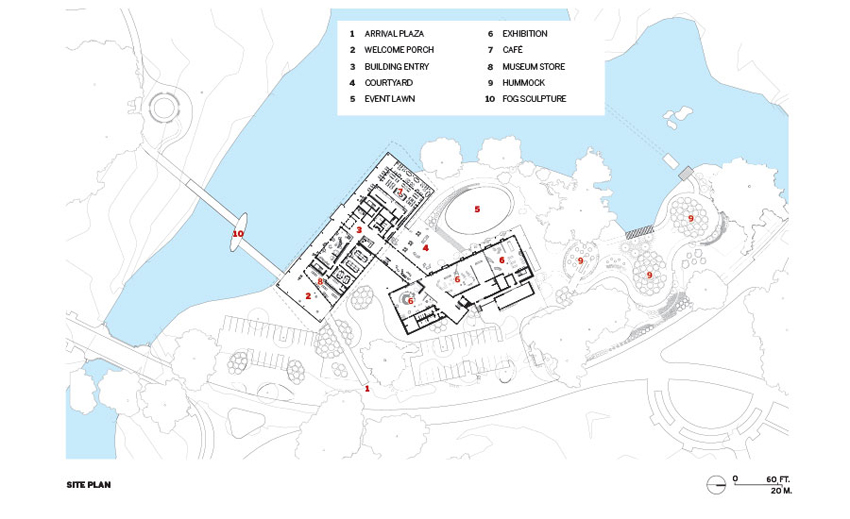
Indeed, the overall design encourages meandering. Mithun transformed the previously flat site, once part of a golf course, to create a rolling topography that mimics the hummocks and hollows—shallow rises and depressions—characteristic of Southern Louisiana landscapes, and regraded the lagoon, softening it to establish a living shoreline and carving out areas for wetlands. A diatom-shaped platform at the center of a bridge over the lagoon includes a fog sculpture—by artist Fujiko Nakaya, who consulted on Diller + Scofidio’s 2002 Blur Building—that softly erupts into a dense mist every 20 minutes. “There’s still trauma associated with water in New Orleans,” says Mithun design partner Richard Franko. “We want to connect with water in a positive way.”


PHOTOGRAPHY © KEVIN SCOTT
A DIATOM-SHAPED platform includes a fog sculpture that erupts into a mist over the lagoon every 20 minutes (top). An outdoor seating area of the café overlooks the water (bottom).
The building sits on 60-foot-deep piles and is set 5 feet above existing grade for flood mitigation. The steel structure is painted a yellow green to evoke new botanical shoots, another important aspect of the design. Leafy plants inhabit the wetland areas, while grassy species are planted upland. The entire landscape is conceived as a sensory garden, with edible plantings, but also highly aromatic and colorful ones such as anise plants and pink muhly grass. The oaks provide a high canopy year-round.
The choreography of the visitor experience of the landscape and the architecture connects children (and adults) from across the city and region to nature, increasing the museum’s focus on environmental education. Part of a parkwide plan to include more institutions—City Park is home to several, including an art museum and botanical garden—LCM’s extensive landscape and outdoor programming allowed it to reopen earlier than others during the coronavirus shutdown.
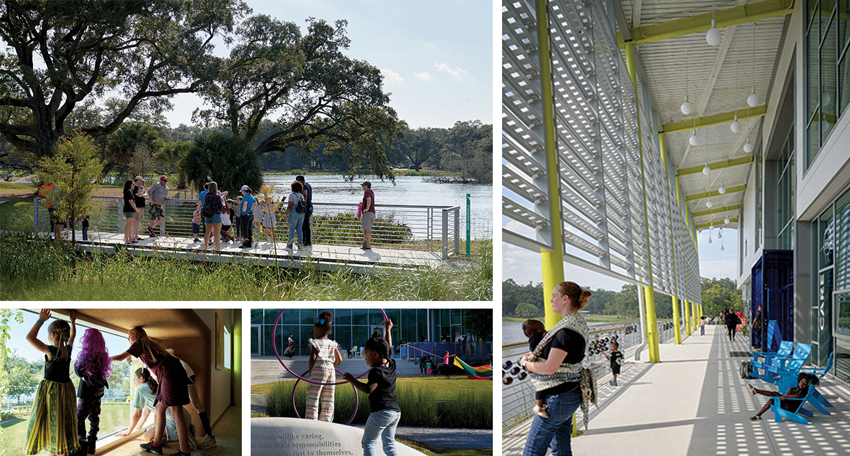
PHOTOGRAPHY © KEVIN SCOTT
MATURE OAKS were preserved (top left). A contemporary version of a New Orleans-style porch includes glass beads along the railing that were inspired by Mardi Gras beads (left). Design elements including 12 “kindows” (bottom, left) and benches (bottom right) were scaled to children.
The landscape design adheres to the guidelines of the New Orleans Water Plan pilot project, which aims to address increasingly frequent high-water levels. The lagoon could function as a stormwater basin to relieve pressure on the canal systems. A second water system captures rainwater from the building roofs and parking areas and feeds it to bioretention swales, while a portion of it is diverted to a 9,000-gallon cistern that feeds irrigation. Existing live oaks and related drainage patterns were integrated into the site grading and carefully protected during construction. “We layered a new, more resilient system on top of what’s already a fairly artificial one,” Runge points out.
The building, too, features sustainable strategies, and is currently tracking for LEED Gold certification. To deal with the city’s subtropical climate, the structure features radiant cooling in the concrete slabs, with a dessicant wheel in the intake airstream to dry the humid outdoor air. There are also large overhangs and a generous porch, the kind for which New Orleans is famous. The project exceeds energy code through a high-performance envelope—over 4,000 linear feet of perforated louvers provide solar control at the porch—and a high-efficiency mechanical system. (The roof is set up for a PV array, with conduit infrastructure, though one is not yet installed.)
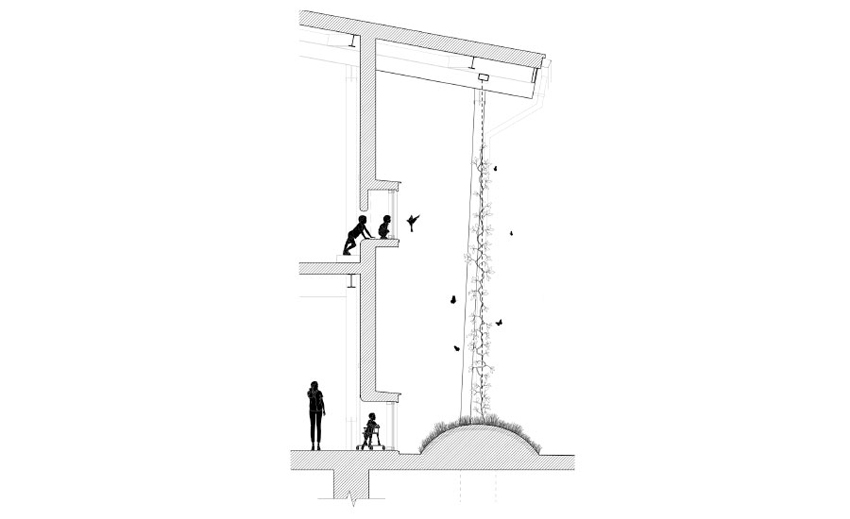

About a third of the new building— 18,000 square feet—is dedicated to exhibitions, which include a life-size interactive chessboard sharing New Orleans history, and a display about the “Mighty Mississippi.” (A floating classroom takes groups out on the lagoon and provides a different perspective on the land from the water.) The museum’s south wing features a literacy center and parent-resource center providing families with free information and educational events.
Opened last August, the new museum is located near public transportation, and is meant to be accessible to all school groups and families. “We wanted it to be more welcoming, more beautiful, more inclusive,” says Bland. “The play factor here is dramatic, along with the way parents are engaging with their children. The community has really embraced this place.”
Credits
Architect: Mithun-- — Richard Franko, design partner; Joshua Distler, project architect; Michael Fiegenschuh, project manager; Gregory Catron; Jason Steiner, design visualization; Bob Trahan; Debra Guenther, landscape architecture partner; Christian Runge, landscape architect; Annie Rummelhoff, interior designer associate Architect: Waggonner & Ball
Engineers: Schrenk Endom & Flanagan (civil); Thornton Tomasetti (structural); Arup (m/e/p)
General Contractor: Roy Anderson
Consultants: Gyroscope (exhibition design); Bayou Tree Service (arborist); JRS Engineering (building envelope); Integrated Design Lab (daylighting); Pastorek Habitats (planting)
Client: Louisiana Children’s Museum
Size: 56,400 square feet
Cost: $47.5 million (total); $33.4 (construction)
Completion date: August 2019
Sources
Exterior metal panels: Berridge
Curtain Wall: Southern Walls and Windows
Glass: Viracon
Locksets: Assa Abloy roofing: Soprema
Surf and Turf
Brooklyn Bridge Park by Michael Van Valkenburgh Associates nears completion with Pier 3.
BY BETH BROOME
OVER 20 YEARS, Brooklyn Bridge Park, designed by Michael Van Valkenburgh Associates (MVVA), has transformed a 1.3-mile stretch of a once-gritty industrial waterfront into a lush and treasured resource for New York. The completion of Pier 3, one of the last major elements—and the final of five piers to be developed—has been timely, providing a verdant landscape for locals to retreat to during the pandemic. With its loosely defined program, this park on a pier has drawn a range of visitors as they temporarily leave behind the stresses of dense urban living during a summer of COVID restrictions.

PHOTOGRAPHY: © ELIZABETH FELICELLA, EXCEPT AS NOTED; ALEX MACLEAN (LEFT)
PIER 3 abuts the busy BQE on one side, faces Manhattan on the other, and sits adjacent to Pier 2’s basketball courts (left). Cedar dune fencing and recovered black locust log “benches” offer coastal references (right).
The long, narrow 85-acre park is squeezed between the Brooklyn–Queens Expressway and the East River, a tidal estuary, with Manhattan’s skyline just beyond. Managed by the not-for-profit Brooklyn Bridge Park Corporation, the park includes eight acres of private development—largely condos and a hotel—that provides the income for maintenance and operations. The first portion, Pier 1, was completed in 2010 (ARCHITECTURAL RECORD, January 2011). Today, the park—which attracts over 5 million visitors annually—includes piers dedicated to soccer fields and basketball courts, as well as playgrounds, a marina, fishing and barbecuing areas, zones for kayaking, and a spine-like greenway along the shore that links the pieces and is well-used by cyclists and runners.
To this mix, Pier 3 brings 4.6 acres of cultivated nature and recreation space, a balance of active and passive use. “Pier 3 provides a different take on the concept of play, as well as a more traditional pastoral destination,” says Michael Van Valkenburgh. “Brooklyn Bridge Park is extroverted, water-centric, but with Pier 3, we wanted a place that was more introverted.” Retaining the steel frame of the warehouse that once occupied the pier, the team left the original concrete deck at the perimeter exposed, to create a promenade. Passing across this rough industrial edge and through the steel ghost of the warehouse, you enter a green oasis.


PHOTOGRAPHY: © KELCO CONSTRUCTION
THE AMORPHOUS shape of the central lawn creates nooks for gathering.
The biggest challenge of putting landscape on a site like this, points out MVVA principal Jason Siebenmorgen, is accommodating the weight of soil—especially the depth required for shade trees. In the project’s early stages, the pier’s existing wood piles were reinforced with rebar and concrete that was pumped into fiberglass forms installed to surround them. Existing seawalls were then removed and replaced with riprap edges on the adjacent shoreline. Finally, to create some separation from the mainland, the team cut out the deck that connected the pier to the greenway, installing two concrete bridges instead. To build topography on this flat surface without overloading the structure, MVVA erected a system of lightweight geofoam blocks. Pier 3 (most of which sits below the 100-year-flood line) is designed to withstand water inundation. Because 2012’s Hurricane Sandy flooded the park and dislodged the foam on Pier 5, a geotextile was used this time to anchor the material. On top of this is a 30-inch layer of sand, subsoil, and topsoil. Runoff (greatly reduced by the dramatic reduction of impervious surfaces) flows into plant beds, with their porous sandy soil mix; the rest is directed into the East River.

PHOTOGRAPHY: SCOTT SHIGLEY
Toward the water, the scale of plantings diminishes. Mooring bollards add to the Discovery Garden’s playscape (opposite, bottom).
Hillocks and gentle rises lend this park-within-a-park a bowl shape, and define its expansive central lawn, which is flanked by meandering paths, an open event plaza, and the labyrinthine Discovery Garden, with its funhouse mirrors and “whisper room.” In plan, the lawn resembles an amoeba, with numerous curvy nooks, perfect for small private gatherings and picnics. “We had never heard of social distancing when we designed the park,” says Van Valkenburgh. “But the concept was there—in the public realm, many of us like to have separation.” Low cedar dune fencing appears to be holding back dense growth as if to prevent it from jumping out onto the tamed grass.

MVVA used a resilient, salt-tolerant plant palette that includes bayberry, beach rose, witch hazel, switch grass, and quaking aspen. Juniper brings year-round greenery. The horticultural staff here is deeply invested in ecology, says Siebenmorgen: Brooklyn Bridge Park is managed organically, irrigation is used sparingly—largely to help establish new plantings—and maintenance is adjusted according to such things as pollination studies, which might, for example, indicate when to prune. This jibes well with MVVA’s “natural and rowdy” general aesthetic, notes Siebenmorgen. “Plants are not sitting clipped and well-behaved in the corner,” he says. “They brush up against your ear or touch your arm—it’s about that kind of physical interaction.” While larger plantings—oak, black cherry, coffee trees, lindens, and hedgerows—are inland, moving toward the waterfront, the scale comes down with scrubby specimens such as sea kale, sassafrass, salt shrub, Mauntauk daisy, and beach pea. The overall effect is that of an accelerated trip through a chain of microclimates: from forest to meadow to headland.

A SANDY BEACH facing Pier 3 is a popular play spot. Steel framing from a former warehouse delineates the lush interior of the pier, and new concrete bridges connect it to the mainland.
In recent months, the park’s users have changed dramatically. Gone are the tourists, which usually make up about a third of visitors, and there are fewer New Yorkers from distant ends of the boroughs. But even during the lockdown, Pier 3’s—and the larger Brooklyn Bridge Park’s—mission to bring respite to the diverse city has not changed. “We’re all very different, and we’re not really all that very different,” says Van Valkenburgh. “We think we’re moving fast-forward on a rocket ship, which in many ways we are, but not experientially. Smelling a rose a hundred years ago affected my grandfather the same way it affects me. That’s what I love about landscape: its enduring quality, no matter what your background is.”
Credits
Architect: Michael Van Valkenburgh Associates — Michael Van Valkenburgh, Matthew Urbanski, Paul Seck, Scott Streeb, Andy Wisniewski, Nik Elkovitch, Jason Siebenmorgen, Tyler Krob, Leo Miller
Engineers: CH2M/Jacobs (marine); Altieri Sebor Wieber (electrical); E2PM (structural)
Consultants: Domingo Gonzalez Associates (lighting); F2 Environmental Design (soil science); Northern Designs (irrigation); CNC Construction (concrete benches); Open (graphic design)
General Contractor: Kelco Construction
Client: Brooklyn Bridge Park
Size: 4.6 acres
Cost: $13 million (landscape); $13 million (marine)
Completion date: July 2018
Sources
Landscape Furnishings: MVVA custom
Play equipment: Richter Spielgeräte
SURFACEDESIGN CREATES A PUBLIC WATERFRONT PARK ON A CORPORATE SITE IN SEATTLE
BY KARA MAVROS
JAMES LORD and Roderick Wyllie, partners at the San Francisco–based landscape firm Surfacedesign, acknowledge that new tech parks can often feel anonymous. To prevent this effect, especially when working with corporate clients, they always seek to strike the balance between flexibility and character in their landscapes. “We’re not asking people to come and be nowhere—we’re asking people to come and be where they are,” explains Wyllie. The “where,” in this case, is the 2.6-acre “Beach” at Expedia Group’s new campus on the shores of Seattle’s Puget Sound. Formerly belonging to a biotech company, the entire 40-acre site became the travel giant’s headquarters last fall.
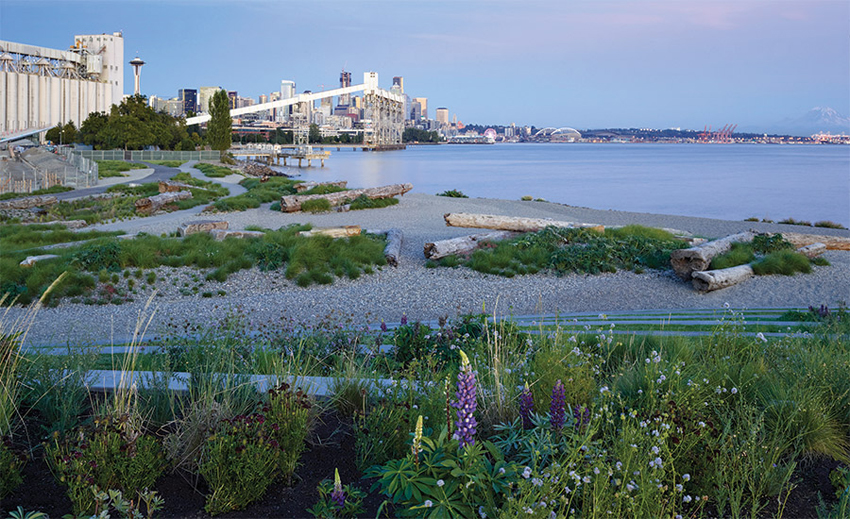
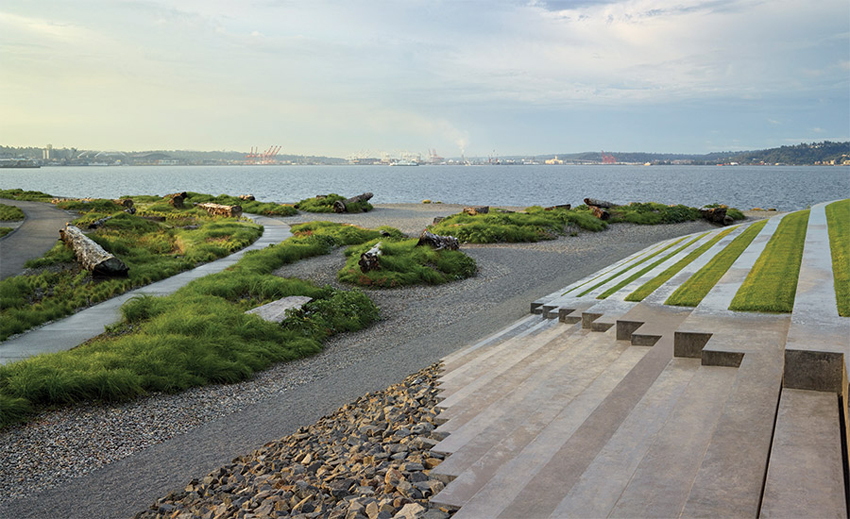
PHOTOGRAPHY: © MARION BRENNER
Though the site underwent heavy remediation, neighboring reminders of its industrial past remain (top). Elevated concrete “terraces” (bottom) create a wind barrier and seating areas.
The Beach, a privately owned park that is open to the public, is part of a larger campus that includes a new building by ZGF and a small pavilion by Aidlin Darling, all tied together by an overall landscaping scheme. This waterfront area, which is a patchwork of tall grasses and, in addition, layers pebbles and driftwood throughout the site, also overlaps with a portion of the Elliott Bay Trail, a popular running and biking path for locals. Here, Surfacedesign separated the existing bike and pedestrian paths and rounded a 90-degree turn into a gentle arc for added safety.
“We talked about how to pull people out from their desks into the landscape,” says Lord, pointing to the increased productivity that comes from spending time in nature. “The big move,” as he calls it, was extending the urban waterfront edge deeper into the site, “to the front door of Expedia’s campus,” by taming the previously inaccessible shoreline with pathways, plantings, and seating.
Before this slice of land was home to corporate entities, it was a more rugged kind of workplace. Its previous life included a series of commercial finger piers that served as a crossroads for the shipping, railroad, and logging industries that have defined the Pacific Northwest for generations.
Slowly, over the years, the site was filled in, leaving Surfacedesign to conduct extensive soil remediation. “The success of any landscape is what happens underground,” explains Lord. As part of its site analysis, the team worked with soil scientists to concoct bespoke “compost teas” of helpful bacteria and fungi, among other microbes, to inoculate the land for optimal planting conditions—all part of a chemical-free bioretention strategy considered “salmon-safe.”
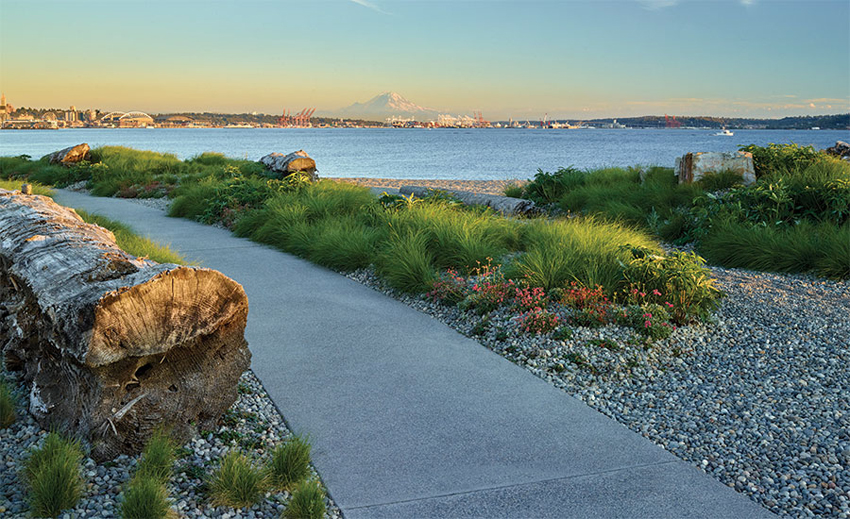

Native wetland species and repurposed driftwood (top) were used throughout the park. The logs, which serve as benches, face views of Mt. Rainier in the distance.
To manage stormwater runoff, Surfacedesign subtly graded the entire site. Where the park comes to a point, on the footprint
of a former pier, an elevated series of curved concrete “terraces,” padded with grass between levels, descends toward the water, designed to provide a graceful wind barrier to those in the lookout area. Amid these elevated forms live a variety of mostly native wetland plantings, including tufted hairgrass and meadow barley, that naturally treat runoff before it flows into the sound. These meadows were designed as alternatives to seawalls, able to defend against rising seas. Here, wild patches of grassy flora sway in the coastal breeze, resilient in the face of the Pacific Northwest’s unpredictable elements. Repurposed driftwood logs from a neighboring port are used as seating around the Beach, strategically placed to maximize views of the Seattle skyline and Mt. Rainier in the distance.
Though intended for outdoor meetings, the Beach has been hosting small musical performances, yoga, and other open-air activities, even during recent months seized by COVID-19. “Especially in these times, it has been a huge relief,” says Lord of the park. “There’s nothing more exciting than that Titanic-esque moment of being out on the point looking back at the city, the Sound, the Olympic Mountains, and realizing where you are in the world and how special Seattle is.”










































